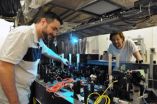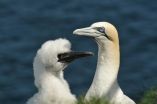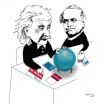(Press-News.org) TORONTO, ON – For the first time, physicists at the University of Toronto (U of T) have overcome a major challenge in the science of measurement using quantum mechanics. Their work paves the way for great advances in using quantum states to enable the next generation of ultra-precise measurement technologies.
"We've been able to conduct measurements using photons – individual particles of light – at a resolution unattainable according to classical physics," says Lee Rozema, a Ph.D. candidate in Professor Aephraim Steinberg's quantum optics research group in U of T's Department of Physics, and one of the lead authors along with M.Sc. candidate James Bateman of a report on the discovery published online today in Physical Review Letters. "This work opens up a path for using entangled states of light to carry out ultra-precise measurements."
Many of the most sensitive measurement techniques in existence, from ultra-precise atomic clocks to the world's largest telescopes, rely on detecting interference between waves – which occurs, for example, when two or more beams of light collide in the same space. Manipulating interference by producing photons in a special quantum state known as an "entangled" state – the sort of state famously dismissed by a skeptical Albert Einstein as implying "spooky action at a distance" – provided the result Rozema and his colleagues were looking for. The entangled state they used contains N photons which are all guaranteed to take the same path in an interferometer – either all N take the left-hand path or all N take the right-hand path, but no photons leave the pack.
The effects of interference are measured in devices known as "interferometers." It is well known that the resolution of such a device can be improved by sending more photons through it – when classical light beams are used, increasing the number of photons (the intensity of the light) by a factor of 100 can improve the resolution of an interferometer by a factor of 10. However, if the photons are prepared in a quantum-entangled state, an increase by a factor of 100 should improve the resolution by that same full factor of 100.
The scientific community already knew resolution could be improved by using entangled photons. Once scientists figured out how to entangle multiple photons the theory was proved correct but only up to a point. As the number of entangled photons rose, the odds of all photons reaching the same detector and at the same time became astronomically small, rendering the technique useless in practice.
So Rozema and his colleagues developed a way to employ multiple detectors in order to measure photons in entangled states. They designed an experimental apparatus that uses a "fibre ribbon" to collect photons and send them to an array of 11 single-photon detectors.
"This allowed us to capture nearly all of the multi-photons originally sent," says Rozema. "Sending single photons as well as two, three and four entangled photons at a time into our device produced dramatically improved resolution."
The U of T experiment built on a proposal by National University of Singapore physicist Mankei Tsang. In 2009, Tsang posited the idea of placing detectors at every possible position a photon could reach so that every possible event could be recorded, whether or not multiple photons hit the same detector. This would enable the calculation of the average position of all the detected photons, and could be done without having to discard any of them. The theory was quickly tested with two photons and two detectors by University of Ottawa physicist Robert Boyd.
"While two photons are better than one, we've shown that 11 detectors are far better than two," says Steinberg, summarising their advancement on Boyd's results. "As technology progresses, using high-efficiency detector arrays and on-demand entangled-photons sources, our techniques could be used to measure increasingly higher numbers of photons with higher resolution."
The discovery is reported in a study titled "Scalable spatial superresolution using entangled photons" published in the June 6 issue of Physical Review Letters. It is recommended as an Editor's Suggestion, and is accompanied by a commentary in the journal Physics which describes the work as a viable approach to efficiently observing superresolved spatial interference fringes that could improve the precision of imaging and lithography systems.
INFORMATION:
In addition to Steinberg, Rozema and Bateman's collaborators on the research included Dylan Mahler, Ryo Okamoto of Hokkaido and Osaka Universities, Amir Feizpour, and Alex Hayat, now at the Technion - Israel Institute of Technology. Support for the research was provided by the Natural Sciences and Engineering Research Council of Canada and the Canadian Institute for Advanced Research, as well as the Yamada Science Foundation.
MEDIA CONTACTS:
Lee Rozema
Department of Physics
University of Toronto
lrozema@physics.utoronto.ca
416-946-3162
Aephraim Steinberg
Department of Physics
University of Toronto
steinberg@physics.utoronto.ca
416-978-0713
Sean Bettam
Communications, Faculty of Arts & Science
University of Toronto
s.bettam@utoronto.ca
416-946-7950
University of Toronto physicists take quantum leap toward ultra-precise measurement
2014-06-02
ELSE PRESS RELEASES FROM THIS DATE:
One in 4 children with leukemia not taking maintenance medication, study shows
2014-06-02
(WASHINGTON, June 2, 2014) – An estimated 25 percent of children in remission from acute lymphocytic leukemia (ALL) are missing too many doses of an essential maintenance medication that minimizes their risk of relapse, according to a study published online today in Blood, the Journal of the American Society of Hematology. The study also reports that maintenance medication adherence was lower in African American and Asian children in remission from ALL than in non-Hispanic white children, with 46 percent of African Americans and 28 percent of Asians not taking enough to ...
No apparent link between chronic cerebrospinal venous insufficiency and MS
2014-06-02
There appears to be no link between chronic cerebrospinal venous insufficiency and multiple sclerosis (MS), according to new research published in CMAJ (Canadian Medical Association Journal).
In 2009, Dr. Paolo Zamboni postulated that chronic cerebrospinal venous insufficiency is a cause of MS, an inflammatory disease of the central nervous system that affects people in northern climates in particular. Published evidence has not been able to find a link to MS, and no one has been able replicate his findings. Several recent studies have shown an association between ultrasound-diagnosed ...
Fishing boats are powerful seabird magnets
2014-06-02
It's no surprise that seabirds are attracted to fishing boats, and especially to the abundance of discards that find their way back into the ocean. But researchers reporting in the Cell Press journal Current Biology on June 2 now find that those boats influence bird behavior over much longer distances than scientists had expected.
Specifically, each boat creates a "halo of influence" across an area measuring about 22 kilometers. That's 13.6 miles—a distance a little longer than a half marathon.
"While we knew that seabirds, including gannets, regularly followed fishing ...
Success for scientists in the academic job market is highly predictable
2014-06-02
The number of scientists in training vastly exceeds the number that will successfully land a faculty position at an academic institution. Now, researchers report in the Cell Press journal Current Biology on June 2 that an individual scientist's chances are very predictable based solely on his or her publication record.
The likelihood of getting that faculty job depends mostly on the number of publications, the impact factor of the journals in which those papers are published, and the number of papers that receive more citations than would be expected based on the journal ...
Gannet sat nav reveals impact of fishing vessels
2014-06-02
Fishing vessels have a far bigger ecological footprint than previously thought, according to research which tracked the movement and behaviour of seabirds using GPS devices.
A team of scientists led by the University of Exeter discovered that northern gannets change their behaviour in response to the presence of large vessels such as trawlers, suggesting each boat can significantly influence the distribution and foraging patterns of these and other marine predators.
Northern gannets (Morus bassanus) are known to feed on discards from fishing vessels as well as diving ...
Rolling old river is indeed changing
2014-06-02
This release is also available in Chinese on EurekAlert! Chinese.
The Hudson River has changed in many far-reaching ways over the past quarter-century as a result of human activity, reports a team of researchers in the June issue of BioScience. Zebra mussels and other invasive species have changed the river's ecology—although the influence of the zebra mussels now seems to be waning.
A 40 percent increase in the freshwater flow has also had powerful effects, and these seem to be countering the effects of higher temperatures, especially in summer. Pollution by chlorinated ...
No harm in yoga: But not much help for asthma sufferers
2014-06-02
ARLINGTON HEIGHTS, Ill. (May 29, 2014) – Yoga has long been promoted as a method for improving physical and mental well-being. And although yoga is often suggested to asthma sufferers to help alleviate symptoms, a new study found little evidence that yoga will improve symptoms.
Researchers of the report, which is published in the June issue of Annals of Allergy, Asthma & Immunology, the scientific journal of the American College of Allergy, Asthma and Immunology (ACAAI), examined 14 previously published studies to determine the effectiveness of yoga in the treatment of ...
New launchers for analyzing resistance to impacts and improving armor plating
2014-06-02
This news release is available in Spanish. At these specialized facilities, which are linked to the UC3M-Airbus Group Joint Center, scientists are studying how structural elements react to applied loads at both low and high speeds. Phenomena of this sort can occur during maintenance operations (a tool falling in an aircraft) or while the elements are functioning. In the case of an airplane, for example, it can happen when a pebble hits an airplane during takeoff, or when a slab of ice comes off of a propeller or the leading edge of a wing and hits the fuselage.
"Our ...
Nano world: Where towers construct themselves
2014-06-02
This news release is available in German. Imagine a tower builds itself into the desired structure only by choosing the appropriate bricks. Absurd – and however, in the nano world this is reality: There an unordered crowd of components can initiate the formation of an ordered structure – a process known as self-assembly. The physicists Christos Likos (University of Vienna), Emanuela Bianchi and Gerhard Kahl (both Vienna University of Technology) investigate how they can control the ordering of such self-assembling structures and found out how to switch the assembly ...
Physicist builds useful light source from harmonic generation
2014-06-02
MANHATTAN, KANSAS — A Kansas State University physicist's proposal may lead to a new way of creating tabletop light sources in the laboratory.
Cheng Jin, research associate in physics; Chii-Dong Lin, university distinguished professor of physics; and collaborators are developing a way to greatly enhance the generation of high-order harmonics to create powerful small tabletop light sources that are important to science and technology.
The researchers are building theoretical framework and providing experimental guidance in the area of strong-field physics. The work is ...






